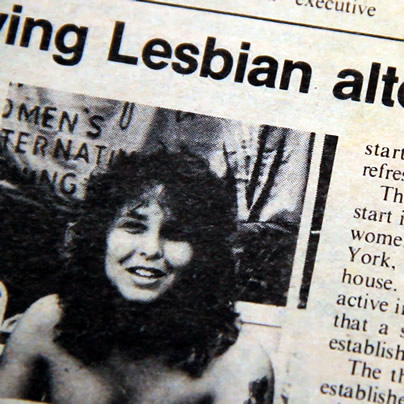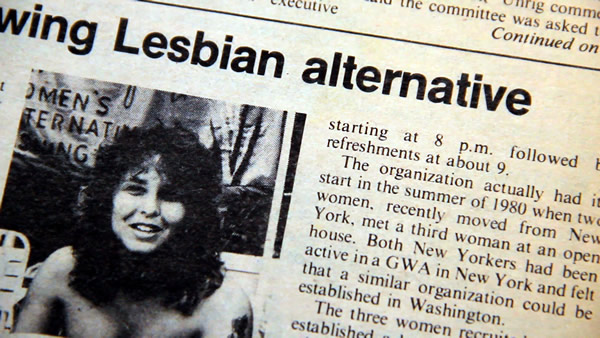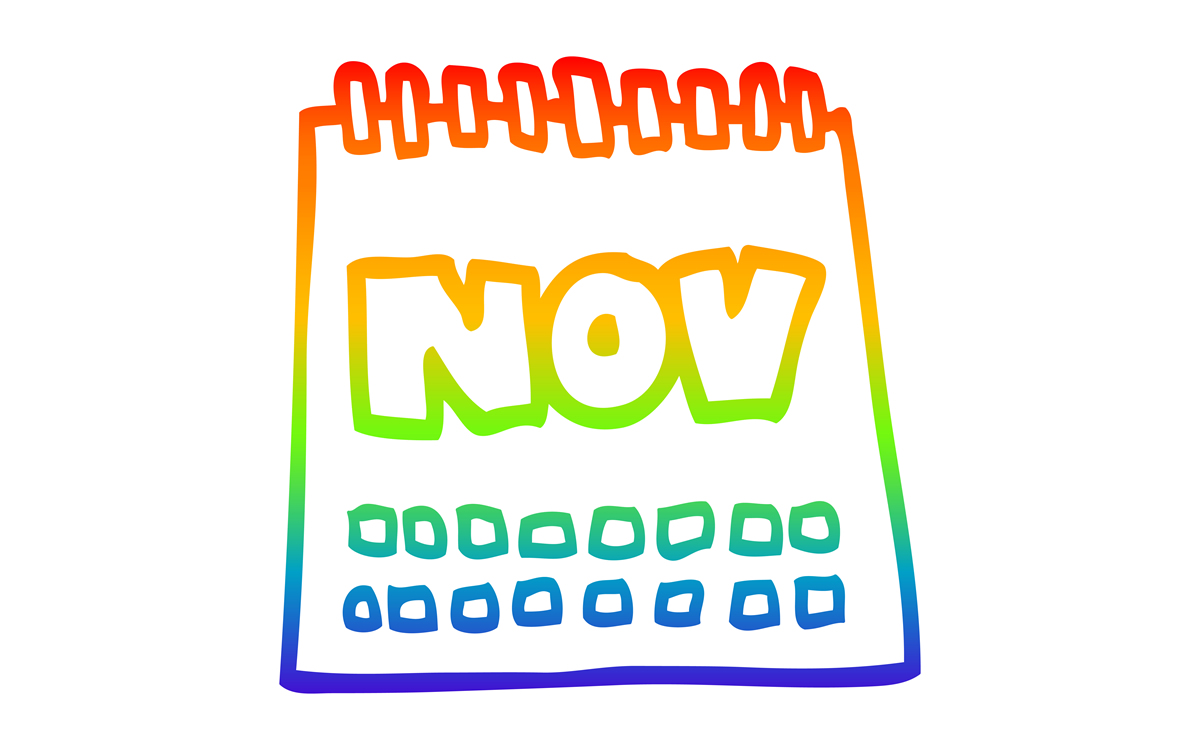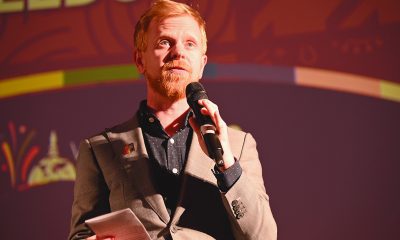Arts & Entertainment
Lesbian seeks support for new documentary
Student chronicling effort behind D.C. Women’s Initiative


A vintage clipping used in Kelsey Brannan’s in-the-works lesbian documentary. (Image courtesy of Brennan)
A local director is seeking the support of the LGBT community to help her tell a story she’s passionate about.
Georgetown University student Kelsey Brannan and the Washington Blade are hosting a preview of Brannan’s upcoming documentary “Labor of Love” at the Blade offices (1712 14th St., 2nd floor) on Dec. 13 at 7 p.m. Following the 10-minute preview will be a Q&A segment with Brannan and subjects of the film.
Complimentary wine will be served and guests are encouraged to network, socialize and discuss what they would like from a new space.
“Labor of Love” follows the D.C. Women’s Initiative, founded this past March, in its mission to establish a physical space to connect lesbians in the community and existing organizations together. Their goal is to open a space in March. The documentary also includes vignettes highlighting the history of former lesbian spaces in D.C., including Sisterspace and Lammas Bookstore.
In the film, former Lammas Bookstore owner Denise Bump reflects on the impact the store had, saying it was part of a movement of women helping other women. She hopes to see something similar in the new center. Bump is head of the D.C. Women’s Initiative and will be available during the event’s Q&A segment.
The evening is largely a fundraising event. Brannan is attempting to reach a goal of $15,000 by Jan. 1. The funds will go to hiring a full-time editor, composer and cinematographer and cover other production costs. She has raised $2,800 through startsomegood.com. All donations will be canceled if she does not meet the goal by the deadline. While she is confident she will be successful, if she falls short, Brannan said she will explore other outlets of fundraising.
She hopes the event will generate interest in the documentary throughout the lesbian community. In a written statement, Brannan says, “The event is designed to get people more engaged with the project, secure more donors and get feedback from the community about what women want from a new space.”
Brannan estimates that about 40 percent of her filming is complete, thanks to “the generosity of my friends with cameras.” Filming will continue in January and February and the documentary will premiere in late April.
Brannan began developing the film as her master’s thesis project, which she defends in May. When she first arrived in Washington, Brannan searched for a physical space where she and other lesbians could spend time and connect with the community. In a video statement on her film’s website (laboroflovefilm.org), she says she discovered a history of such spaces, which no longer exist, compiled by the Rainbow History Project.
“It’s hard to tap into a community when you move to a new place,” Brannan says, commenting on her early days in D.C. “I wanted to look into the past to see why these spaces existed and why they disappeared.”
This personal desire to find a community became the inspiration for her film.
The project has two components. Brannan plans to expand the documentary and show it at festivals, including the Reel Affirmations Xtra series in June. There is also an archive on the film’s site featuring clips, interview segments and personal stories about the importance of having such spaces for women. Brannan plans for the project to be ongoing.
In the film, D.C. Women’s Initiative member June Crenshaw explains how such a space would fill a void in the community.
“The space is not going take the place of all of the organizations and groups that are out there doing a whole host of wonderful things,” she says, “but it’s really going to provide that centralized place for us to find each other.”
Brannan credits her community as a driving force behind the documentary and appreciates the support she has received. “Every woman I interviewed was a huge part of the project,” she says. “Without them, it wouldn’t be possible, and without the D.C. Women’s Initiative space, I wouldn’t have a narrative.”
Movies
Superb direction, performances create a ‘Day’ to remember
A rich cinematic tapestry with deep observations about art, life, friendship

According to writer/director Ira Sachs, “Peter Hujar’s Day” is “a film about what it is to be an artist among artists in a city where no one was making any money.” At least, that’s what Sachs – an Indie filmmaker who has been exploring his identities as both a gay and Jewish man onscreen since his 1997 debut effort, “The Delta” – told IndieWire, with tongue no doubt firmly planted in cheek, in an interview last year.
Certainly, money is a concern in his latest effort – which re-enacts a 1974 interview between photographer Peter Hujar (Ben Whishaw) and writer Linda Rosenkrantz (Rebecca Hall), as part of an intended book documenting artists over a single 24-hour period in their lives – and is much on the mind of its titular character as he dutifully (and with meticulous detail) recounts the events of his previous day during the course of the movie. To say it is the whole point, though, is clearly an overstatement. Indeed, hearing discussions today of prices from 1974 – when the notion of paying more than $7 for Chinese takeout in New York City seemed outrageous – might almost be described as little more than comic relief.
Adapted from a real-life interview with Hujar, which Rosenkrantz published as a stand-alone piece in 2021 (her intended book had been abandoned) after a transcript was discovered in the late photographer’s archives, “Peter Hujar’s Day” inevitably delivers insights on its subject – a deeply influential figure in New York culture of the seventies and eighties, who would go on to document the scourge of AIDS until he died from it himself, in 1987. There’s no plot, really, except for the recalled narrative itself, which involves an early meeting with a French journalist (who is picking up Hujar’s images of model Lauren Hutton), an afternoon photo shoot with iconic queer “Beat Generation” poet/activist Allen Ginsburg, and an evening of mundane social interaction over the aforementioned Chinese food. Yet it’s through this formalized structure – the agreed-upon relation of a sequence of events, with the thoughts, observations, and reflections that come with them – that the true substance shines through.
In relaying his narrative, Hujar exhibits the kind of uncompromising – and slavishly precise – devotion to detail that also informed his work as a photographer; a mundane chronology of events reveals a universe of thought, perception, and philosophy of which most of us might be unaware while they were happening. Yet he and Rosenkrantz (at least in Sachs’ reconstruction of their conversation) are both artists who are keenly aware of such things; after all, it’s this glimpse of an “inner life,” of which we are rarely cognizant in the moment, that was/is their stock-in-trade. It’s the stuff we don’t think of while we’re living our lives: the associations, the judgments, the selective importance with which we assign each aspect of our experiences, that later become a window into our souls – if we take the opportunity to look through it. And while the revelations that come may occasionally paint them in a less-than-idealized light (especially Hujar, whose preoccupations with status, reputation, appearances, and yes, money, often emerge as he discusses the encounter with Ginsberg and his other interactions), they never feel like definitive interpretations of character; rather, they’re just fleeting moments among all the others, temporary reflections in the ever-ongoing evolution of a lifetime.
Needless to say, perhaps, “Peter Hujar’s Day” is not the kind of movie that will be a crowd-pleaser for everyone. Like Louis Malle’s equally acclaimed-and-notorious “My Dinner With Andre” from 1981, it’s essentially an action-free narrative comprised entirely of a conversation between two people; nothing really happens, per se, except for what we hear described in Hujar’s description of his day, and even that is more or less devoid of any real dramatic weight. But for those with the taste for such an intellectual exercise, it’s a rich and complex cinematic tapestry that rewards our patience with a trove of deep observations about art, life, and friendship – indeed, while its focus is ostensibly on Hujar’s “day,” the deep and intimate love between he and Rosenkrantz underscores everything that we see, arguably landing with a much deeper resonance than anything that is ever spoken out loud during the course of the film – and never permits our attention to flag for even a moment.
Shooting his movie in a deliberately self-referential style, Sachs weaves the cinematic process of recreating the interview into the recreation itself, bridging mediums and blurring lines of reality to create a filmed meditation that mirrors the inherent artifice of Rosenkrantz’s original concept, yet honors the material’s nearly slavish devotion to the mundane minutiae that makes up daily life, even for artists. This is especially true for both Hujar and Rosenkrantz, whose work hinges so directly to the experience of the moment – in photography, the entire end product is tied to the immediacy of a single, captured fragment of existence, and it is no less so for a writer attempting to create a portrait (of sorts) composed entirely of fleeting words and memories. Such intangibles can often feel remote or even superficial without further reflection, and the fact that Sachs is able to reveal a deeper world beyond that surface speaks volumes to his own abilities as an artist, which he deploys with a sure hand to turn a potentially stagnant 75 minutes of film into something hypnotic.
Of course, he could not accomplish that feat without his actors. Whishaw, who has proven his gifts and versatility in an array of film work including not only “art films” like this one but roles from the voice of Paddington Bear to “Q” in the Daniel Craig-led “James Bond” films, delivers a stunning performance, carrying at least 75% of the film’s dialogue with the same kind of casual, in-the-moment authenticity as one might expect at a dinner party with friends; and though Hall has less speaking to do, she makes up for it in sheer presence, lending a palpable sense of respect, love, and adoration to Rosenkrantz’s relationship with Hujar.
In fact, by the time the final credits role, it’s that relationship that arguably leaves the deepest impression on us; though these two people converse about the “hoi polloi” of New York, dropping legendary names and reminding us with every word of their importance in the interwoven cultural landscape – evoked with the casual air of everyday routine before it becomes cemented as history – of their era, it’s the tangible, intimate friendship they share that sticks with us, and ultimately feels more important than any of the rest of it. For all its trappings of artistic style, form, and retrospective cultural commentary, it’s this simple, deeply human element that seems to matter the most – and that’s why it all works, in the end. None of its insights or observations would land without that simple-but-crucial link to humanity.
Fortunately, its director and stars understand this perfectly, and that’s why “Peter Hujar’s Day” has an appeal that transcends its rarified portrait of time, place, and personality. It recognizes that it’s what can be read between the lines of our lives that matters, and that’s an insight that’s often lost in the whirlwind of our quotidian existence.
Out & About
Gala Hispanic Theatre’s Flamenco Festival returns

Gala Hispanic Theater will host the 21st Annual “Fuego Flamenco Festival” from Thursday, Nov. 6 to Saturday, Nov. 22.
The festival will feature American and international artists who will gather in the nation’s capital to celebrate the art of Flamenco. Guests can save 20% on tickets with a festival pass.
The festival kicks off now through Nov. 10 with the D.C. premiere of Crónica de un suceso, created, choreographed and performed by Rafael Ramírez from Spain, accompanied by renowned flamenco singers and musicians. In this new show, Ramírez pays homage to the iconic Spanish Flamenco artist Antonio Gades who paved the way for what Flamenco is today. GALA’s engagement is part of an eight-city tour of the U.S. by Ramírez and company.
The magic continues Nov. 14-16 with the re-staging of the masterpiece Enredo by Flamenco Aparicio Dance Company, a reflection of the dual nature of the human experience, individual and social, which premiered at GALA in 2023.
For more information, visit the theatre’s website.

Friday, November 7
“Center Aging Friday Tea Time” will be at 12 p.m. in person at the DC Center for the LGBT Community’s new location at 1827 Wiltberger St., N.W. To RSVP, visit the DC Center’s website or email [email protected].
Go Gay DC will host “LGBTQ+ Community Social” at 7 p.m. at Silver Diner Ballston. This event is ideal for making new friends, professional networking, idea-sharing, and community building. This event is free and more details are available on Eventbrite.
Saturday, November 8
Go Gay DC will host “LGBTQ+ Community Brunch” at 12 p.m. at Freddie’s Beach Bar & Restaurant. This fun weekly event brings the DMV area LGBTQ+ community, including allies, together for delicious food and conversation. Attendance is free and more details are available on Eventbrite.
Sunday Supper on Saturday will be at 2 p.m. at the DC Center for the LGBT Community. This event will be full of food, laughter and community. For more information, email [email protected].
Monday, November 10
“Center Aging: Monday Coffee Klatch” will be at 10 a.m. on Zoom. This is a social hour for older LGBTQ adults. Guests are encouraged to bring a beverage of choice. For more information, contact Adam ([email protected]).
“Soulfully Queer: LGBTQ+ Emotional Health and Spirituality Drop-In” will be at 3 p.m. at the DC Center for the LGBT Community. This group will meet weekly for eight weeks, providing a series of drop-in sessions designed to offer a safe, welcoming space for open and respectful conversation. Each session invites participants to explore themes of spirituality, identity, and belonging at their own pace, whether they attend regularly or drop in occasionally. For more details visit the DC Center’s website.
Genderqueer DC will be at 7 p.m. on Zoom. This is a support group for people who identify outside of the gender binary, whether you’re bigender, agender, genderfluid, or just know that you’re not 100% cis. For more details, visit genderqueerdc.org or Facebook.
Wednesday, November 12
Job Club will be at 6 p.m. on Zoom. This is a weekly job support program to help job entrants and seekers, including the long-term unemployed, improve self-confidence, motivation, resilience and productivity for effective job searches and networking — allowing participants to move away from being merely “applicants” toward being “candidates.” For more information, email [email protected] or visit thedccenter.org/careers.
“Gay Men Speed Dating” will be at 7 p.m. at Public Bar Live. This is a fresh alternative to speed dating and matchmaking in a relaxed environment. Tickets start at $37 and are available on Eventbrite.
Thursday, November 13
The DC Center’s Fresh Produce Program will be held all day at the DC Center for the LGBT Community. People will be informed on Wednesday at 5 p.m. if they are picked to receive a produce box. No proof of residency or income is required. For more information, email [email protected] or call 202-682-2245.
Virtual Yoga Class will be at 7 p.m. on Zoom. This is a free weekly class focusing on yoga, breathwork, and meditation. For more details, visit the DC Center for the LGBT Community’s website.
-

 District of Columbia2 days ago
District of Columbia2 days ago‘Sandwich guy’ not guilty in assault case
-

 Sports3 days ago
Sports3 days agoGay speedskater racing toward a more inclusive future in sports
-

 Celebrity News5 days ago
Celebrity News5 days agoJonathan Bailey is People’s first openly gay ‘Sexiest Man Alive’
-

 Michigan4 days ago
Michigan4 days agoFBI thwarts Halloween terror plot targeting Mich. LGBTQ bars




















